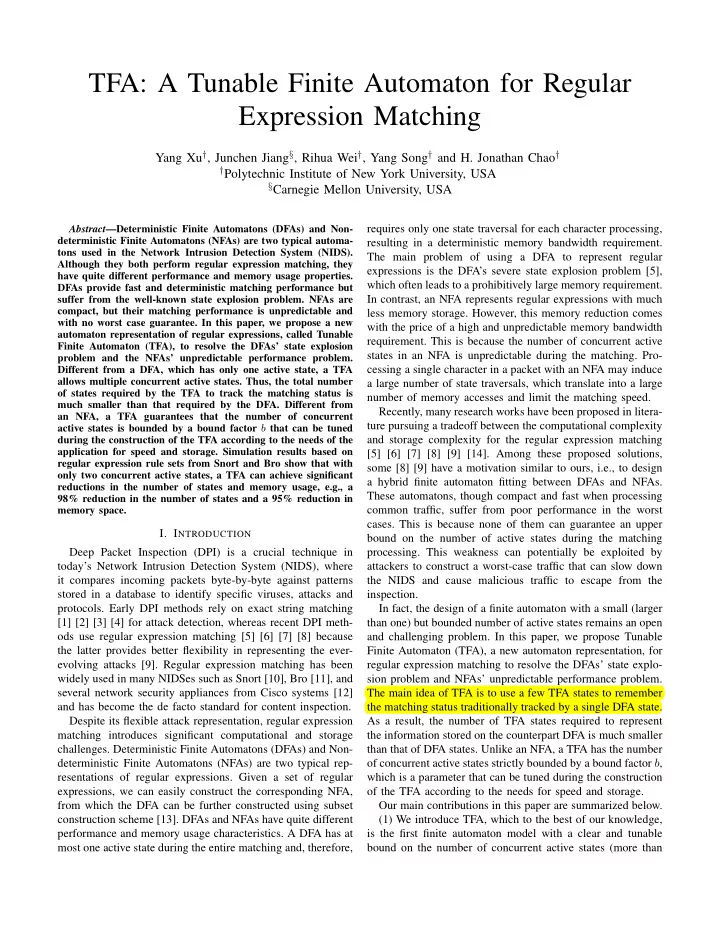

TFA: A Tunable Finite Automaton for Regular Expression Matching Yang Xu † , Junchen Jiang § , Rihua Wei † , Yang Song † and H. Jonathan Chao † † Polytechnic Institute of New York University, USA § Carnegie Mellon University, USA requires only one state traversal for each character processing, Abstract —Deterministic Finite Automatons (DFAs) and Non- deterministic Finite Automatons (NFAs) are two typical automa- resulting in a deterministic memory bandwidth requirement. tons used in the Network Intrusion Detection System (NIDS). The main problem of using a DFA to represent regular Although they both perform regular expression matching, they expressions is the DFA’s severe state explosion problem [5], have quite different performance and memory usage properties. which often leads to a prohibitively large memory requirement. DFAs provide fast and deterministic matching performance but In contrast, an NFA represents regular expressions with much suffer from the well-known state explosion problem. NFAs are compact, but their matching performance is unpredictable and less memory storage. However, this memory reduction comes with no worst case guarantee. In this paper, we propose a new with the price of a high and unpredictable memory bandwidth automaton representation of regular expressions, called Tunable requirement. This is because the number of concurrent active Finite Automaton (TFA), to resolve the DFAs’ state explosion states in an NFA is unpredictable during the matching. Pro- problem and the NFAs’ unpredictable performance problem. Different from a DFA, which has only one active state, a TFA cessing a single character in a packet with an NFA may induce allows multiple concurrent active states. Thus, the total number a large number of state traversals, which translate into a large of states required by the TFA to track the matching status is number of memory accesses and limit the matching speed. much smaller than that required by the DFA. Different from Recently, many research works have been proposed in litera- an NFA, a TFA guarantees that the number of concurrent ture pursuing a tradeoff between the computational complexity active states is bounded by a bound factor b that can be tuned and storage complexity for the regular expression matching during the construction of the TFA according to the needs of the application for speed and storage. Simulation results based on [5] [6] [7] [8] [9] [14]. Among these proposed solutions, regular expression rule sets from Snort and Bro show that with some [8] [9] have a motivation similar to ours, i.e., to design only two concurrent active states, a TFA can achieve significant a hybrid finite automaton fitting between DFAs and NFAs. reductions in the number of states and memory usage, e.g., a These automatons, though compact and fast when processing 98% reduction in the number of states and a 95% reduction in common traffic, suffer from poor performance in the worst memory space. cases. This is because none of them can guarantee an upper I. I NTRODUCTION bound on the number of active states during the matching Deep Packet Inspection (DPI) is a crucial technique in processing. This weakness can potentially be exploited by today’s Network Intrusion Detection System (NIDS), where attackers to construct a worst-case traffic that can slow down it compares incoming packets byte-by-byte against patterns the NIDS and cause malicious traffic to escape from the stored in a database to identify specific viruses, attacks and inspection. protocols. Early DPI methods rely on exact string matching In fact, the design of a finite automaton with a small (larger [1] [2] [3] [4] for attack detection, whereas recent DPI meth- than one) but bounded number of active states remains an open ods use regular expression matching [5] [6] [7] [8] because and challenging problem. In this paper, we propose Tunable the latter provides better flexibility in representing the ever- Finite Automaton (TFA), a new automaton representation, for evolving attacks [9]. Regular expression matching has been regular expression matching to resolve the DFAs’ state explo- widely used in many NIDSes such as Snort [10], Bro [11], and sion problem and NFAs’ unpredictable performance problem. several network security appliances from Cisco systems [12] The main idea of TFA is to use a few TFA states to remember and has become the de facto standard for content inspection. the matching status traditionally tracked by a single DFA state. Despite its flexible attack representation, regular expression As a result, the number of TFA states required to represent matching introduces significant computational and storage the information stored on the counterpart DFA is much smaller challenges. Deterministic Finite Automatons (DFAs) and Non- than that of DFA states. Unlike an NFA, a TFA has the number deterministic Finite Automatons (NFAs) are two typical rep- of concurrent active states strictly bounded by a bound factor b , resentations of regular expressions. Given a set of regular which is a parameter that can be tuned during the construction expressions, we can easily construct the corresponding NFA, of the TFA according to the needs for speed and storage. from which the DFA can be further constructed using subset Our main contributions in this paper are summarized below. construction scheme [13]. DFAs and NFAs have quite different (1) We introduce TFA, which to the best of our knowledge, performance and memory usage characteristics. A DFA has at is the first finite automaton model with a clear and tunable most one active state during the entire matching and, therefore, bound on the number of concurrent active states (more than
Recommend
More recommend